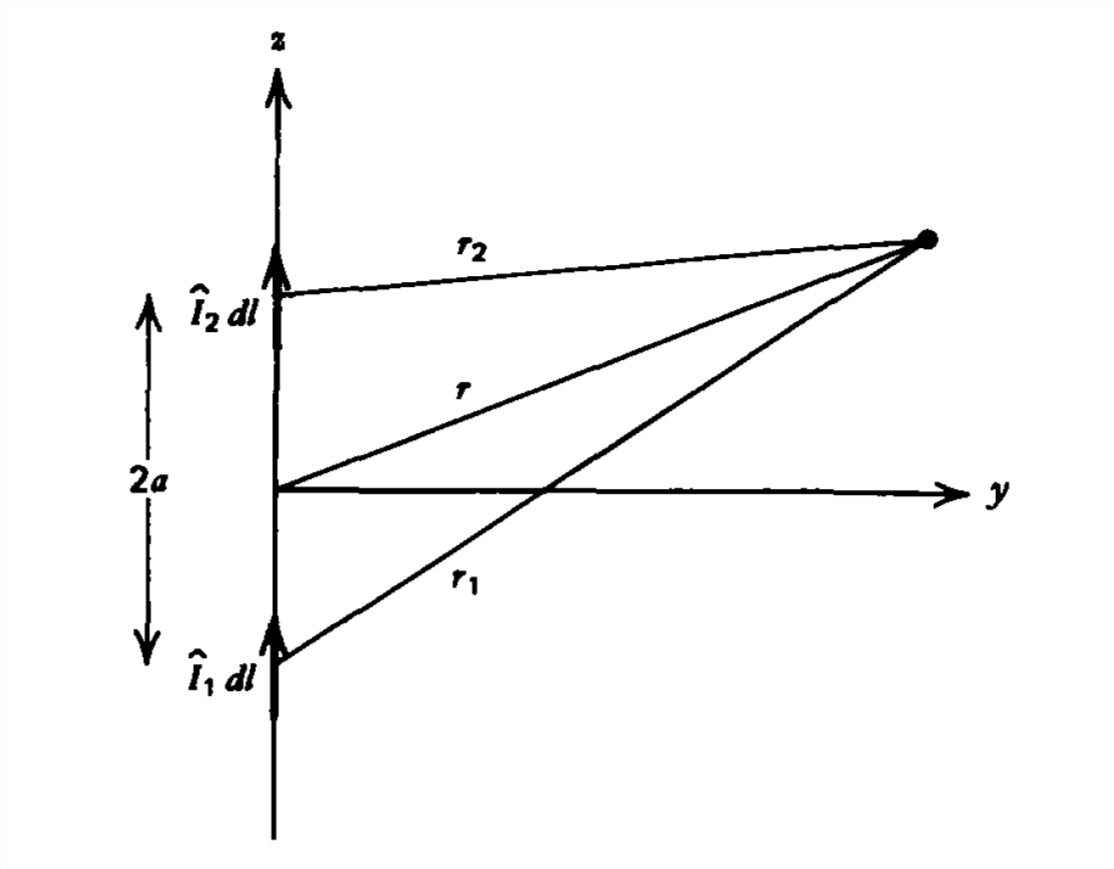9.5: Problems
- Page ID
- 83362
Section 9.1
We wish to find the properties of waves propagating within a linear dielectric medium that also has an Ohmic conductivity \(\sigma \).
(a) What are Maxwell's equations in this medium?
(b) Defining vector and scalar potentials, what gauge condition decouples these potentials?
(c) A point charge at \(r=0\) varies sinusoidally with time as \(\mathcal{Q}\left ( t \right )=\textrm{Re}\left ( \hat{\mathcal{Q}}e^{j\omega t} \right )\). What is the scalar potential?
(d) Repeat (a)-(c) for waves in a plasma medium with constitutive law
\(\frac{\partial \textbf{J}_{f}}{\partial t}=\omega _{p}^{2}\varepsilon \textbf{E}\)
An infinite current sheet at \(z=0\) varies as \(\textrm{Re}\left [ K_{0}e^{j\left ( \omega t-k_{x}x \right )}\textbf{i}_{x} \right ]\)
(a) Find the vector and scalar potentials.
(b) What are the electric and magnetic fields?
(c) Repeat (a) and (b) if the current is uniformly distributed over a planar slab of thickness \(2a\):
\(\textbf{J}_{f}=\left\{\begin{array}{ll}
\displaystyle J_{0}e^{j\left ( \omega t-k_{x}x \right )}\textbf{i}_{x},&\quad -a< z< a\\
\displaystyle 0,&\quad \left |z \right |> a
\end{array}\right. \)
A sphere of radius \(R\) has a uniform surface charge distribution \(\sigma _{f}=\textrm{Re}\left ( \hat{\sigma }_{0}e^{j\omega t} \right )\) where the time varying surface charge is due to a purely radial conduction current.
(a) Find the scalar and vector potentials, inside and outside the sphere. (Hint: \(r_{\mathcal{Q}P}^{2}=r^{2}+R^{2}-2rR\cos \theta ;\quad r_{\mathcal{Q}P}dr_{\mathcal{Q}P}=rR\sin \theta d\theta \).)
(b) What are the electric and magnetic fields everywhere?
Section 9.2
Find the effective lengths, radiation resistances and line charge distributions for each of the following current distributions valid for \(\) on a point electric dipole with short length \(\left | z \right |< dl/2\):
(a) \(\hat{I}\left ( z \right )=I_{0}\cos \alpha z\)
(b) \(\hat{I}\left ( z \right )=I_{0}e^{-\alpha \left | z \right |}\)
(c) \(\hat{I}\left ( z \right )=I_{0}\cosh \alpha z\)
What is the time-average power density, total time-average power, and radiation resistance of a point magnetic dipole?
A plane wave electric field \(\textrm{Re}\left ( \textbf{E}_{0}e^{j\omega t} \right )\) is incident upon a perfectly conducting spherical particle of radius \(R\) that is much smaller than the wavelength.
(a) What is the induced dipole moment? (Hint: See Section 4-4-3.)
(b) If the small particle is, instead, a pure lossless dielectric with permittivity \(\varepsilon \), what is the induced dipole moment?
(c) For both of these cases, what is the time-average scattered power?
A plane wave magnetic field \(\textrm{Re}\left ( \textbf{H}_{0}e^{j\omega t} \right )\) is incident upon a perfectly conducting particle that is much smaller than the wavelength.
(a) What is the induced magnetic dipole moment? (Hint: See Section 5-7-2ii and 5-5-1.)
(b) What. are the re-radiated electric and magnetic fields?
(c) What is the time-average scattered power? How does it vary with frequency?
(a) For the magnetic dipole, how are the magnetic field lines related to the vector potential \(\textbf{A}\)?
(b) What is the equation of these field lines?
Section 9.3
Two aligned dipoles \(\hat{I}_{1}dl\) and \(\hat{I}_{2}dl\) are placed along the \(z\) axis a distance \(2a\) apart. The dipoles have the same length while the currents have equal magnitudes but phase difference \(\mathcal{X}\).

(a) What are the far electric and magnetic fields?
(b) What is the time-average power density?
(c) At what angles is the power density zero or maximum?
(d) For \(2a=\lambda /2\), what values of \(\mathcal{X}\) give a broadside or end-fire array?
(e) Repeat (a)-(c) for \(2N+1\) equally spaced aligned dipoles along the \(z\) axis with incremental phase difference \(\mathcal{X}_{0}\).
Three dipoles of equal length \(dl\) are placed along the \(z\) axis.

(a) Find the far electric and magnetic fields.
(b) What is the time average power density?
(c) For each of the following cases find the angles where the power density is zero or maximum.
(i) \(\hat{I}_{1}=\hat{I}_{3}=\hat{I}_{0},\hat{I}_{2}=2\hat{I}_{0}\)
(ii) \(\hat{I}_{1}=\hat{I}_{3}=\hat{I}_{0},\hat{I}_{2}=-2\hat{I}_{0}\)
(iii) \(\hat{I}_{1}=-\hat{I}_{3}=\hat{I}_{0},\hat{I}_{2}=2j\hat{I}_{0}\)
Many closely spaced point dipoles of length \(dl\) placed along the \(x\) axis driven in phase approximate a \(z\)z-directed current sheet \(\textrm{Re}\left ( K_{0}e^{j\omega t}\textbf{i}_{z} \right )\) of length \(L\).

(a) Find the far fields from this current sheet.
(b) At what angles is the power density minimum or maximum?
Section 9.4
Find the far fields and time-average power density for each of the following current distributions on a long dipole:
\(\left ( a \right )\quad \hat{I}\left ( z \right )=\left\{\begin{array}{ll}
I_{0}\left ( 1-2z/L \right ),&\quad 0< z< L/2\\
I_{0}\left ( 1+2z/L \right ),&\quad -L/2< z< 0
\end{array}\right.\)
Hint:
\(\int z\,e^{az}dz=\frac{e^{az}}{a^{2}}\left ( az-1 \right )\)
\(\left ( b \right )\quad \hat{I}\left ( z \right )=I_{0}\cos \pi z/L,\quad -L/2< z< L/2\)
Hint:
\(\int e^{az}\cos pz\,dz=e^{az}\frac{\left ( a\cos pz+p\sin pz \right )}{\left ( a^{2}+p^{2} \right )}\)
\(\left ( c \right )\quad \)For these cases find the radiation resistance when \(kL\ll 1\).


